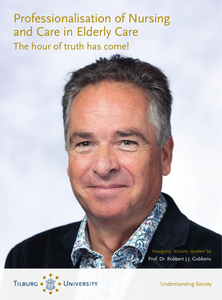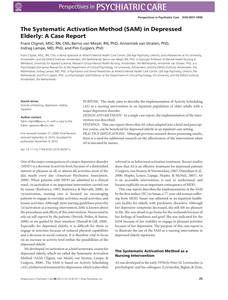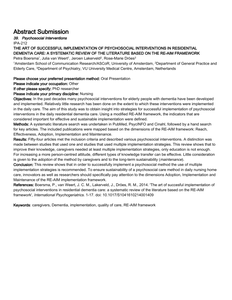Inaugural lecture, delivered upon public acceptance of the endowed professorship in Professionalisation of Nursing and Care in Elderly Care by Prof. Dr. Robbert J.J. Gobbens at Tilburg University on 29 September 2023.
DOCUMENT

A Dutch healthcare organisation modernizes its real estate portfolio to meet today’s requirements and acquired an office building for conversion into a nursing home for elderly with dementia. The purpose of the research has been to study the design principles for elderly with dementia, for innovative and smart application in work processes and the acquired building.Methods – Using multiple-method qualitative research design, bachelor thesis students of a university of applied sciences explored the reconstruction of the acquired building and related healthcare processes. Results – Application of design principles for the elderly with dementia were studied, among which were interior design, catering process, and connection with the neighbourhood. Feasible interior ideas were elaborated, intentions for change in the catering process were confirmed by stakeholders, and an action plan for neighbourhood connections was delivered. Elements are being used for a final design. Implementation has to be checked with close scrutiny.Originality – The application of design principles for elderly with dementia (design, favourable state, beautiful moments) together with changes in work processes of health care employees aiming at patient-centred care is a new combination. Practical or social implications – When a healthcare organisation chooses a new care concept, not only the surroundings change. Also, the processes around people and the way we take care of them change. In many ways a new concept can only succeed when the employees and the way they work change as well.
MULTIFILE

The proportion of elderly people in the society is constantly growing. The elderly who live alone form one of the most vulnerable groups in the society that is also at considerable risk for poverty and social isolation. According to the last population census in Estonia (2011), 39.3% of the elderly (65+) lived alone. The ageing of the population is accompanied by novel challenges, among them especially the coping of the elderly living alone. In 2015, the research team at the Tallinn University School of Governance, Law and Society conducted a study to map Estonian community-based practices that are available for the elderly (65+), especially for those who live alone at home, and the way these practices support interdependent coping and prevent the need for institutional care. This study, based on qualitative and quantitative data collected in Estonian communities, suggests that cooperation between Estonian local governments and communities should be more effective and involve regular interaction. Promising practices include developing network-based community support models and broadening communication possibilities.
LINK
Current many changes are taking place in the elderly care: care is changing from supply-oriented to demand driven, problems have to be more serious than previously to get a placement in a nursing home, furthermore the demand for heavier care will increase due to ageing. The aim of this study is to acquire a clear insight in the decision-making process with regard to placement in a nursing home facility.
DOCUMENT
Introduction Many health care interventions have been developed that aim to improve or maintain the quality of life for frail elderly. A clear overview of these health care interventions for frail elderly and their effects on quality of life is missing. Purpose To provide a systematic overview of the effect of health care interventions on quality of life of frail elderly. Methods A systematic search was conducted in Embase, Medline (OvidSP), Cochrane Central, Cinahl, PsycInfo and Web of Science, up to and including November 2017. Studies describing health care interventions for frail elderly were included if the effect of the intervention on quality of life was described. The effects of the interventions on quality of life were described in an overview of the included studies. Results In total 4,853 potentially relevant articles were screened for relevance, of which 19 intervention studies met the inclusion criteria. The studies were very heterogeneous in the design: measurement of frailty, health care intervention and outcome measurement differ. Health care interventions described were: multidisciplinary treatment, exercise programs, testosterone gel, nurse home visits and acupuncture. Seven of the nineteen intervention studies, describing different health care interventions, reported a statistically significant effect on subdomains of quality of life, two studies reported a statistically significant effect of the intervention on the overall quality of life score. Ten studies reported no statistically significant difference between the intervention and control groups. Conclusion Reported effects of health care interventions on frail elderly persons’ quality of life are inconsistent, with most of the studies reporting no differences between the intervention and control groups. As the number of frail elderly persons in the population will continue to grow, it will be important to continue the search for effective health care interventions. Alignment of studies in design and outcome measurements is needed.
MULTIFILE

Through a qualitative examination, the moral evaluations of Dutch care professionals regarding healthcare robots for eldercare in terms of biomedical ethical principles and non-utility are researched. Results showed that care professionals primarily focused on maleficence (potential harm done by the robot), deriving from diminishing human contact. Worries about potential maleficence were more pronounced from intermediate compared to higher educated professionals. However, both groups deemed companion robots more beneficiary than devices that monitor and assist, which were deemed potentially harmful physically and psychologically. The perceived utility was not related to the professionals' moral stances, countering prevailing views. Increasing patient's autonomy by applying robot care was not part of the discussion and justice as a moral evaluation was rarely mentioned. Awareness of the care professionals' point of view is important for policymakers, educational institutes, and for developers of healthcare robots to tailor designs to the wants of older adults along with the needs of the much-undervalued eldercare professionals.
DOCUMENT

The continuing aging of the population sparked off a public discussion on the extent of state care of elderly people. A historical evaluation of the Dutch system of family care is an essential part in the above discussion, especially regarding options like self-aid and 'mantelzorg'. Using population registers, household stutters of elderly people in the periode 1920-1940 were reconstructed for two different regions in the Netherlands. The most important conclusion of this investigation is that the Dutch elderly were, in most cases, living independently, as head (or wife of the head) of the household in which they were residing.
DOCUMENT
The study aims to describe the implementation of Activity Scheduling (AS) as a nursing intervention in an inpatient population of older adults with a major depressive disorder. DESIGN AND METHODS: In a single case report, the implementation of the intervention was described. FINDINGS: This case report shows that AS, when adapted into a brief and prescriptive course, can be beneficial for depressed elderly in an inpatient care setting. PRACTICE IMPLICATIONS: Although previous research shows promising results, there is a need for additional research on the effectiveness of the intervention when AS is executed by nurses.
DOCUMENT

Background: Despite high prevalence of mental problems among elderly migrants in The Netherlands, the use of psychosocial care services by this group is low. Scientific evidence points at the crucial role of social support for mental health and the use of psychosocial services. We therefore explored the role of social networks in the access to psychosocial care among elderly migrants in The Netherlands. Methods: A qualitative study was conducted using semi-structured group interviews and individual interviews. The eight group and eleven individual interviews (respectively n = 58 and n = 11) were conducted in The Netherlands with Turkish, Moroccan, Surinamese, and Dutch elderly. The data were analysed through coding and comparing fragments and recognizing patterns. Results: Support of the social network is important to navigate to psychosocial care and is most frequently provided by children. However, the social network of elderly migrants is generally not able to meet the needs of the elderly. This is mostly due to poor mental health literacy of the social network, taboo, and stigma around mental illness and the busy lives of the social network members. Conclusions: Strategies to address help-seeking barriers should consider mental health literacy in elderly migrants as well as their social networks, and counteract taboos and stigma of mental health problems.
LINK
Presentatie gegeven over de review in Brussel Objectives: In the past decades many psychosocial interventions for elderly people with dementia have been developed and implemented. Relatively little research has been done on the extent to which these interventions were implemented in the daily care. The aim of this study was to obtain insight into strategies for successful implementation of psychosocial interventions in the daily residential dementia care. Using a modified RE-AIM framework, the indicators that are considered important for effective and sustainable implementation were defined.
MULTIFILE
